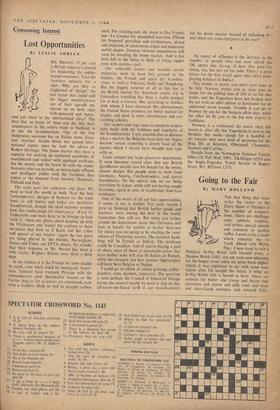Consuming Interest
Lost Opportunities
By LESLIE ADRIAN
Mn. BROWN'S 15 per cent is British industry's reward for neglecting the sophis- ticated consumer. Take the furniture industry for a start. Why are they so frightened of 'design,' the one factor that could pull the bigger manufacturers out of their age-old rut,
shored up on both sides with gimcrack and 'repro,' and put them in the international class? The best that so many of them can do, like their counterparts in the cutlery trade in Sheffield, is to ape the Scandinavians. One of the few indigenous successes has an Italian name, Erco- lani. Another, Archie Shine, has gained inter- national repute since he took the advice of Robert Heritage. The home market may have a capacity for soaking up unlimited quantities of matchboard and veneer with appliqué curlicues, but the money and the future lie with the manu- facturers who can provide an increasingly affluent and intelligent public with the furniture that comes at the moment from Sweden, Denmark, Finland and Italy:
The same goes for tableware and glass. We used to lead the world, in both. Now the best 'contemporary' designs of flatware (as the trade loves to call knives and forks) are derivative Scandinavian, though the most extreme versions look like studio props for Emergency- Ward /0. Tablecloths and mats have to be foreign to look 'with it.' Open any 'glossy about keeping up with the Fitzjoneses and inspect the captions to those set-pieces that look as if Katie and her cubes will appear at any minute-again the star parts are being played by the Swedes. Norwegians, Danes and Finns, our EFTA chums. No wander that their response to Mr. Brown has been a trifle tetchy. Brighter Britain owes them a deep debt.
In the kitchen it is the French we seem unable to catch, even when aided by immigrant Ameri- cans. Sabatier have trumped Prestige with the contemporary cook (hereinafter known as the Carrier bag) as far as knives arc concerned, even With a stainless blade as well as straight carbon
steel. For cooking pots she tends to like French, too-Le Creuset for enamelled cast-iron, Pilivite for fireproof porcelain and earthenware, glazed and unglazed, of anonymous origin and numerous useful shapes. German vitreous enamelware will soon be invading the home market. And it has been left to the Swiss to think of lining copper pans with stainless steel.
Our venerable cotton and woollen textile industries Seem to have lost ground to the Italians, the French and again the Scandina- vians, as well as Pakistan, India and Hongkong. But the biggest surprise of all in this line is the British market for American towels. Up in Lancashire towelling has been a staple product for at least a century. But, according to retailers with whom I have discussed this phenomenon, the United States products are better packed for display and dyed in more adventurous and eye- catching colours.
Our carpets and rugs seem to compare surpris- ingly badly with the boldness and simplicity of the Scandinavians. I was amazed also to discover what a market the Belgians have here for 'repro- duction' cotton carpeting, a dreary facet of the market which I should have thought was typi- cally us.
Look around any large glassware department. It soon becomes crystal clear that any British glassblower should save his breath for the better, cleaner designs that people seem to want from Germany, Austria, Czechoslovakia, and (sorry) Scandinavia. On the optical side we are being overtaken by Japan, while still not having caught Germany, again in spite of established American producers.
One of the worst of all our lost opportunities, it seems to me, is leather. For some reason I grew up thinking that British leather goods and footwear were among the best in the world. Sometimes they still are. But when you traipse around the department stores this Christmas and look at hussifs for aunties or leather desk-sets for uncles you are going to be smelling the sweet odours of Florentine success. The daintiest hand- bags will be French or Italian. The briefcase could be Canadian. And if you're buying -a pair of shoes, most of those at reasonable prices that have leather soles will also be Italian or French, while the cheapest and best summer lightweights will have been Belgian or Italian.
I could go on (think of colour printing, coffee- grinders, even, dammit, raincoats). The question is (and perhaps the Council of Industrial Design knows the answer) would we need to slap on this all-across-the-board tariff if our manufacturers
led the home market instead of following it- and about ten respectful years in the rear?
An aspect of affluence is the increase in the number of people who can now afford the OK sports like ski-ing. (I hear that goes for riding, too, but not yet for polo. There's a great future for the first travel agent who offers polo- playing holidays in India.)
This winter,, it seems, you don't even have to be rich. Norway invites you to skim over its slopes for the piffling sum of £30 or so for two weeks, and the Yugoslays have just broken into the act with an offer almost as handsome for an additional seven pounds. Trouble is you go to Norway by sea for the bargain all-in tour, while the other lot fly you to the big new airport at Ljubljana.
Norway is a traditional ski centre (they did invent it, after all), but Yugoslavia is new to the business this week--except for a handful of ski fanatics who were tired of queueing for the drag lift at Klosters, Obergurgl, Chamonix, Zermatt and Cortina.
Details from the Norwegian National Tourist Office (20 Pall Mall, SW1; TRAfalgar 6255) and the Anglo-Yugoslav Travel Service (6 Rupert Street, WI; REGent 1337).
































 Previous page
Previous page